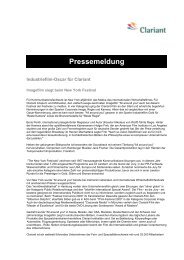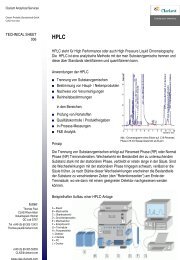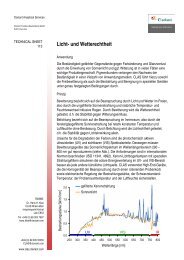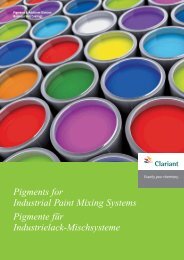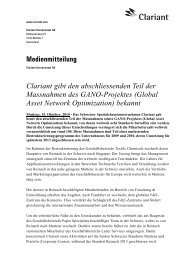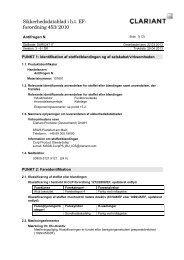CESA® Additive Masterbatches - Clariant
CESA® Additive Masterbatches - Clariant
CESA® Additive Masterbatches - Clariant
You also want an ePaper? Increase the reach of your titles
YUMPU automatically turns print PDFs into web optimized ePapers that Google loves.
The most common flame retardants<br />
include the following:<br />
1 The effectiveness of inorganic<br />
hydroxides (such as magnesium hydroxide<br />
and aluminum trihydroxide) is based<br />
on the dilution of the plastic as a<br />
combustible material – more specifically,<br />
on the dilution of the incendiary gases<br />
and on the absorption of energy by<br />
endothermic reactions. Because of their<br />
very high dosage requirement (>50%),<br />
inorganic hydroxides are preferably<br />
used in compounding.<br />
Flame Retardancy<br />
Flame-retardant rating<br />
according to UL94 testing<br />
V-0<br />
V-1<br />
V-2<br />
non-classified<br />
0<br />
10<br />
2 Halognenated flame retardants<br />
(e.g., brominated and antimony systems)<br />
actively intervene in the free-radicalbased<br />
combustion reactions in the<br />
gaseous phase and form less reactive<br />
byproducts. This delays or interrupts<br />
auto-catalytic combustion. Highly<br />
efficient, halogenated flame retardant<br />
additives are especially suitable for<br />
manufacturing flame retardant<br />
concentrates.<br />
3 Compounds containing phosphorous,<br />
which facilitate the formation of a protective<br />
layer of carbon via the phosphoric<br />
acid produced during a fire. These have<br />
specific effects that are less universal<br />
in application.<br />
halogen-containing<br />
flame retardants<br />
halogen-free<br />
flame retardants<br />
Addition level of flame retardants (%)<br />
20 30<br />
4 Intumescent systems, which cause<br />
the formation of a protective, ceramiclike<br />
layer via a combination of active<br />
agents (organophosphorous compounds<br />
combined with a “foaming agent”).<br />
Intumescent systems also have limited<br />
applications.<br />
CESA-flam masterbatches offer a wide<br />
range of very efficient and universally<br />
usable halogenated flame retardants,<br />
as well as some specific halogen-free<br />
solutions. They are used primarily for<br />
extrusion and injection molding applications<br />
in LDPE, LLDPE, HDPE, PP, PS,<br />
ABS and engineering resins. A few<br />
CESA-flam grades have been specifically<br />
developed for fiber applications.<br />
5



